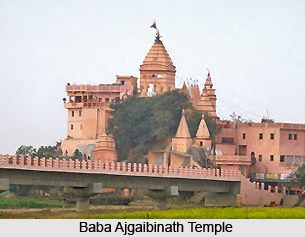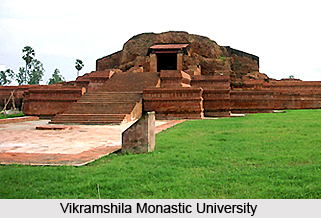 Monuments in Bhagalpur comprise the rock cut carvings of Hindus, Buddhist and Jain deities dating back to the period of the Guptas. The major town, cantonment and headquarters of the district which bears its name, Bhagalpur is a small town situated at about two miles long along the southern bank of the River Ganges and at a distance of four hundred and twenty six kilometers from Kolkata city by rail.
Monuments in Bhagalpur comprise the rock cut carvings of Hindus, Buddhist and Jain deities dating back to the period of the Guptas. The major town, cantonment and headquarters of the district which bears its name, Bhagalpur is a small town situated at about two miles long along the southern bank of the River Ganges and at a distance of four hundred and twenty six kilometers from Kolkata city by rail.
Located in the south western region of the Indian state of Bihar, Bhagalpur is considered to be one of the prominent places in the country. Evidence from our history suggests that the present city of Bhagalpur was known as Champavati in the fifth century BCE, the capital city of Anga, which was one of the sixteen Mahajanapadas. There is a belief that the mother of Emperor Ashoka, Subhadrangi belonged to this city and he made Mahendra, his son, the governor of this provincial city later. Champa was also visited by Lord Buddha and there several people became his followers. The Chinese traveler also visited Champa on his way back home also cited in his accounts several Viharas, Stupas and Buddhist monks.
 The city of Bhagalpur is also one of the municipal corporations of Bihar. One of the oldest districts of the state, Bhagalpur is situated in the southern region on the fertile plane of the basin formed by the Ganga River, at 141 feet above sea level. The place is known all over the world for its silk products and therefore it is also called the `Silk City`. Bhagalpur was known as Bhagdatpuram during the apex of Anga Kingdom. Among the Bhagalpur historical monuments, the Bhagalpur Pillar is the most prominent. The pillar is a mighty monolithic structure which is 17 ft high, located in close proximity to the shore of the River Ghangra. The Bhagalpur pillar possesses a capital at the top, which comprises of a slab of circular shape supporting a cone. The shaft`s central part has been eroded with the age. The east face possesses an inscription constituting twenty two lines and a small epigraph in English. The pillar of this huge structure been constructed by rough grey sand stone and is prayed by the people of the locality. It is believed that the Bhagalpur Pillar has been constructed in 900.
The city of Bhagalpur is also one of the municipal corporations of Bihar. One of the oldest districts of the state, Bhagalpur is situated in the southern region on the fertile plane of the basin formed by the Ganga River, at 141 feet above sea level. The place is known all over the world for its silk products and therefore it is also called the `Silk City`. Bhagalpur was known as Bhagdatpuram during the apex of Anga Kingdom. Among the Bhagalpur historical monuments, the Bhagalpur Pillar is the most prominent. The pillar is a mighty monolithic structure which is 17 ft high, located in close proximity to the shore of the River Ghangra. The Bhagalpur pillar possesses a capital at the top, which comprises of a slab of circular shape supporting a cone. The shaft`s central part has been eroded with the age. The east face possesses an inscription constituting twenty two lines and a small epigraph in English. The pillar of this huge structure been constructed by rough grey sand stone and is prayed by the people of the locality. It is believed that the Bhagalpur Pillar has been constructed in 900.
The carving on rock in Bhagalpur, dating back to the fine Gupta Empire in India from the 5th to the 6th century CE, exhibits a large number of deities belonging to the Buddhists, Jain, and Hindu deities. These artistic engravings were unearthed from Sultanganj and Kahalgaon in Bihar`s Bhagalpur region. The troops of Akbar passed through this place in the year 1573 and 1575. The town and district are littered with Muslim monuments and ruins. Within the town are two monuments to Augustus Cleveland, the local Collector who organized the Bhagalpur Hill Rangers; an auxiliary force which pacified the entire area of the Santal Parganas during the 1780s. The massive brick monument was raised by grateful local landowners; the stone monument, by the Court of Directors of the British East India Company, as a mark of their recognition of his services.
Apart from these, there are several other historical monuments in Bhagalpur which attract people from all over India and also from different parts of the world. These include the famous Vikramshila monastic University, established by Dharamplal, a ruler of the Pala Dynasty. The Shahjangi in Nath Nagar, in the Bhagalpur area is a shrine situated on the hill having a long sacred Idgah located at its bottom. The famous rock cut carvings are found in Sultanganj where one can also find the Baba Ajgaibinath temple amidst the Ganga River. From this place a large and mighty stupa having the bronze statue of Lord Buddha in Abhaymudra, of 7 ft height, was excavated in the year 1861 and the statue is presently in England at the Birmingham city museum. Thus, the Bhagalpur monuments include the Hindus, Jains, Muslims as well as Buddhist monuments.



















